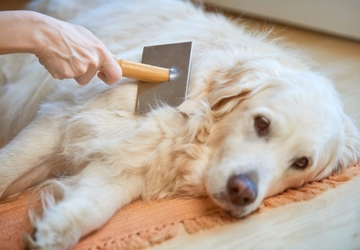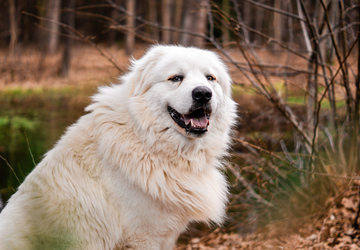Dog owners often wonder when their dogs shed the most. The answer varies by breed and individual dog. Most dogs shed a lot during certain times of the year, known as peak shedding periods. Understanding these patterns can help you predict and control how much fur accumulates in your home.
Seasonal Hair
Dogs typically shed their fur to adjust to fluctuating temperatures. The two most important shedding times for dogs are:
- Spring: Dogs shed their thick winter fur as they anticipate warmer weather.
- Fall: Dogs shed their thinner summer fur to make room for their thicker winter fur.
These shedding cycles are determined by light cycles and temperature fluctuations. Understanding when dogs shed the most during these periods can help you take preventative measures to control your dog's shedding.
Breeds and Coat Patterns

Different breeds of dogs have different coat patterns. For example:
- Double-coated breeds such as Golden Retrievers and Siberian Huskies shed a lot of fur depending on the season.
- Single-coated breeds like Poodles shed less and less.
Understanding your dog's breed-specific coat pattern is essential to identifying when your dog sheds the most. This knowledge can help you effectively manage your dog's shedding.
Frequency of Shedding
While seasonal shedding is common, some dogs shed year-round. Breeds like Labrador Retrievers and Beagles are known for shedding constantly, regardless of the season. This constant shedding can make it seem like the shedding season never ends. Observe their shedding behaviour throughout the year to get a better idea of when these dog breeds shed the most.
Dealing with Your Dog's Shedding Problem
Controlling your dog's shedding requires a combination of grooming, diet, and environmental control. Here are some ways to do it:
- Regular Grooming: Removing loose fur and reducing shedding is easier.
- Bathing: Use a special dog shampoo to clean and condition the coat.
- Healthy Diet: Ensure your dog gets enough nutrients to maintain a strong coat.
- Vacuuming: Clean your home regularly to control fur buildup.
Grooming Tips
Grooming is an important aspect of dealing with your dog's shedding problem. Depending on your dog's coat type, you may need to use special tools:
- Slicker brush: Great for removing loose fur and preventing tangles in double-coated breeds.
- Deshedding tool: Effective for penetrating the undercoat and reducing shedding.
- Rubber curry comb: For short-coated breeds, remove loose fur.
By using proper grooming techniques, you can significantly mitigate the effects of your dog's shedding season.
Environmental Factors
Environmental influences can also affect shedding patterns. Factors like heating, air conditioning, and artificial lighting can disrupt the natural shedding cycle. Here's how to better handle these elements:
- Maintain a constant temperature: Avoid wild temperature swings in your coop.
- Use a humidifier: Maintain humidity levels in your home to avoid dry skin.
- Natural light: Ensure your dog gets enough natural light to regulate its shedding cycle.
These measures can help you control your dog's shedding by creating a more stable environment for your pet.
Nutrition and Nutrients
A balanced diet is essential for a healthy coat and can affect shedding. Make sure your dog's diet contains the following:
- Omega-3 fatty acids: Promotes coat health and slows shedding.
- High-quality protein: Enhances overall coat health.
- Vitamins and minerals: Essential for maintaining healthy skin and coat.
You can control the consequences of your dog's shedding with a nutritious diet.
Common Dietary Supplements
Consider adding the following supplements to your dog's diet to help control your dog's shedding:
- Fish oil: Rich in omega-3 fatty acids.
- Biotin: Enhances skin and coat health.
- Zinc: Essential for a healthy coat.
These supplements play a vital role in maintaining an optimal coat condition.
Health Issues and Shedding
Excessive shedding can sometimes indicate an underlying health issue. Contact your veterinarian if you notice unusual shedding patterns outside the usual shedding season. Common health issues include:
- Allergies: May cause increased shedding and skin irritation.
- Hormonal imbalances: Conditions such as hypothyroidism may trigger excessive shedding.
- Parasites: Fleas and ticks can cause itching and hair loss.
You can better manage shedding and keep your dog healthy by addressing these health issues.
Dogs Living Indoors vs. Outdoors: Differences in Shedding

Dogs Living Indoors
Dogs that Live Indoors exhibit different shedding patterns than those that live outdoors. Factors such as thermoregulation, a stable light cycle, and reduced exposure to environmental influences can influence when a dog sheds the most. For domestic dogs, shedding can be mild during the season, but it can also be more persistent year-round. This constant shedding requires a carefully managed shedding regimen.
Strategies for Domestic Dogs
- Air Purification Systems: These can reduce airborne fur and dander.
- Frequent Grooming: Regular grooming can reduce the accumulation of fur in your living space.
- Regular Veterinary Checkups: Regular veterinary consultations ensure that underlying pathologies affecting hair changes are treated promptly.
Dogs Living Outside
Dogs that live outdoors and are exposed to the natural elements can better adapt to seasonal changes. It is important to consider the significant fluctuations in shedding seasons to understand when a dog sheds the most.
Strategies for Dogs Living Outdoors
- Seasonal Grooming Adjustments: Increase grooming frequency during peak shedding periods.
- Outdoor Hygiene: Clean outdoor resting areas regularly to avoid hair loss.
- Seasonal Diet Adjustments: Ensure diet supports coat health in extreme climate conditions.
Hormonal Effects on Hair Loss
Reproductive Hormones
Reproductive hormones can significantly impact when a dog sheds the most. Female dogs, especially intact female dogs, may experience increased hair loss due to endocrine fluctuations during the estrus cycle.
Dealing with Hair Loss in Intact Female Dogs
- Consider an ovariohysterectomy: Castration can stabilize hormone balance and may reduce hair loss.
- Nutritional supplementation: Supplements that support hormonal health can help control hair loss in dogs.
- Regular veterinary consultations: Regular veterinary checkups to effectively manage hormonal hair loss.
Thyroid Function
Thyroid dysfunction can lead to abnormal hair loss. Hypothyroidism, in particular, is a common cause of excessive hair loss.
Treatment of thyroid-related hair loss
- Thyroid function tests: Routine tests to monitor thyroid health.
- Medication: Make sure thyroid disease is adequately treated with medication.
- Nutritional supplements: Incorporate thyroid-supportive nutrients into your dog's diet.
Environmental Allergies and Hair Loss
Common Allergens
Environmental allergens like pollen, dust, and mould can exacerbate hair loss. By identifying when your dog sheds the most due to allergy triggers, you can develop effective strategies to combat hair loss.
Identify and Reduce Allergens
- Hypoallergenic bedding: Use allergen-free bedding to minimize exposure.
- Careful hygiene: Keep the living space clean and reduce the accumulation of dust and mould.
- Air Filtration Systems: Install air filters to capture allergens in the air.
Seasonal Allergies
Seasonal allergens may also coincide with your dog's shedding season and cause increased shedding during certain times of the year.
Treatment of Seasonal Allergies
- Allergy Medication: Use prescription medications to relieve allergy symptoms.
- Frequent Bathing: During high allergen season, bathe your dog more frequently to remove allergens from the coat.
- Veterinary Monitoring: Seek regular veterinary consultations to effectively manage seasonal allergy symptoms.
Conclusion
Knowing when your dog sheds the most and what factors influence shedding can help you effectively treat your dog's shedding. You can confidently navigate your dog's shedding season by focusing on care, nutrition, environmental control, and health. Implementing these strategies will make dealing with your dog's shedding less daunting and result in a cleaner home and a happier, healthier dog.















